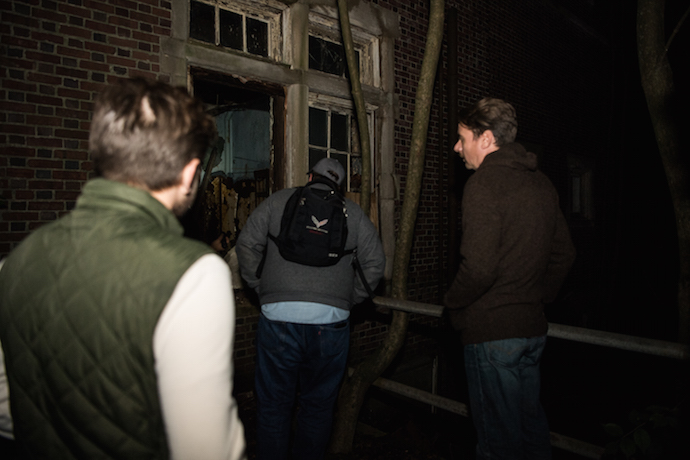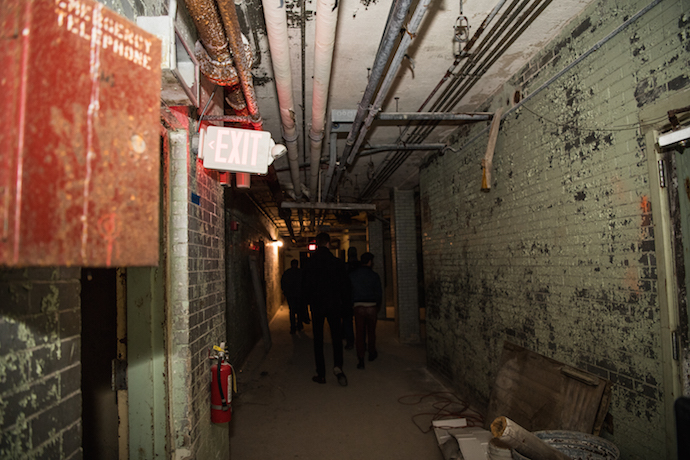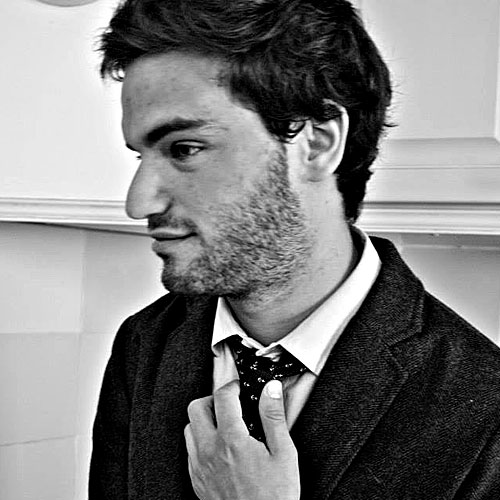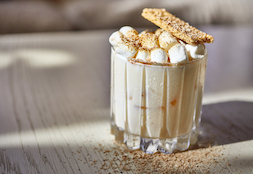It’s approximately 12:30am on Wednesday morning, and I’m leaning against the wall of the notoriously haunted Pennhurst State School and Hospital, in a small town outside of Philadelphia, straining for signs from the long-departed. Was that a knock or a radiator? Was that a voice or a stomach churning? Was that a ghostly grunt or a human fart? These are the questions one must constantly ask himself in the course of a ghost hunt, along with the myriad other questions one must constantly ask of the spirits, like: What’s your name? Will you show us you’re here? Will you whisper something in someone’s ear? Will you touch someone’s leg? Or arm? Or ass? Please, ghost, will you just grab my ass?
It’s a fickle business, communing with the dead, really a sort of strange hybrid between a confounding piece of performance art and an infuriating game of Marco Polo that’s infuriating because nobody ever says Polo. In over three hours, at what our guides insisted was one of the most haunted places in America, I never saw, heard or felt any evidence of the supernatural. Yet where it fails as a search for spirits it succeeds as a theatrical experience. Or non-experience. Because perhaps the most interesting thing about ghost hunting is not what happens, but what doesn’t.
I’d arrived at Pennhurst earlier that day, having been flown in by the kind folks from Chevy. They wanted to use the experience to promote their new Tahoe Midnight Edition, a black-on-black-on-black SUV a few journalists and I drove around the grounds and parked at various locations, for picture-taking purposes. Open from 1918 to 1987, Pennhurst served as a facility for the mentally impaired, who, due to overcrowding and unsound medical practices, were often the subject of gross mistreatment and abuse. It shuttered as a result of losing a landmark court case, Halderman v. Pennhurst State School and Hospital, which ultimately succeeded in granting a litany of new civil rights to the disabled. Once a sprawling campus, complete with lush baseball fields and a swimming pool, it is today overrun with trees, tangled webs of leave-sapped vines strangulating red brick buildings, their windows all but uniformly broken. Stray hospital equipment and solitary-looking chairs litter the grounds; a dilapidated swing set, delivered straight from central scary-movie-casting, occupies a sizable field. To this day, there’s still a network of subterranean tunnels, which were reportedly used to discreetly evacuate dead bodies from the premises. Under its current owner, who apparently refuses to return to the grounds at night, claiming he’d had a spirit follow him home, it now houses several haunted attractions, and additionally licenses one of its buildings, Mayflower Hall, to Ghost Hunters USA, a company that leads ghost hunting expeditions in over 20 haunted locations across the country.
Our ghost hunters included Andrew, a disarmingly normal-seeming “empath”—basically a medium-in-training—who smelled heavily of cologne and used to work in the medical field in Indiana, as well as Tyler, an Englishman with spiked hair who discovered he could convene with the dead when his imaginary childhood friend, Fred, turned out to be less imaginary and more just not-alive. Rounding out our crew were a few reps from Chevy, two fellow journalists and Donna, a loquacious, folksy woman who worked at Pennhurst from roughly ‘77 to close, and who now operates a small museum dedicated to the place. She reminisced about her patients with a lucid and sincere affection, chalking up their erratic behavior (like, say, gathering blankets together in a pile and humping them) to childlike idiosyncrasies. Needless to say, she didn’t strike me as someone who would be afraid of ghosts, the same way I can’t imagine war veterans being terrified of werewolves.

At about 9:30pm, the entire grounds empty but for us, Andrew and Tyler gave us their spiel. They seemed to exist on the same rhetorical plane as proselytizers: their belief manifested itself as performance, thought not necessarily an insincere one. Andrew insisted we’d go in skeptics and come out believers. He’d told me earlier about the crazy shit he’d seen (people’s eyes rolling back, chairs flung across the room, ghostly shadow puppets on the wall) and whether he’d ever felt in danger (yes, he left immediately). Tyler, for his part, seemed genuinely forlorn on the steps to Mayflower Hall. He made a point of saying that he couldn’t come to Pennhurst too often. The place was too haunted; the work was too demanding; the spirits “took a piece out of him.” On several occasions, he’d waken up from terrible nightmares, feeling like he was having a heart attack. I felt bad for him, and felt worse for reflexively thinking his accent was a put-on.
I also assumed, in light of or despite my fear, that they wanted to believe in what they saw, and so they did. That’s not a novel observation, nor is it a condescension. Because the funny thing is, I wanted to believe, too. For a few hours inside, I felt my senses laboring to stretch reality into the dark corners of the unreal, wondering if my stomach hurt because the spirits made it so, or if the sort of standard sighs and murmurs old buildings made were not as innocent as they seemed.
While we were on the first floor, Tyler had a willing participant stand down a hallway and ask a benevolent spirit he affectionately called the Shoelace Man—because he supposedly collected shoelaces, and patients used to commit suicide by hanging themselves with shoelaces—a series of questions on an old Panasonic recorder parapsychologists used to pick up supernatural voices.
“What’s on the third floor?” He asked. “Do we have your permission to go up to the third floor?”
When willing participant came back and we played the recording, there did seem to be an otherworldly voice on it, right at the end. We gathered around and listened closely. I thought it sounded like the word “neg,” even though it seemed highly unlikely that Shoelace Man would be aware of terms popularized by VH1’s The Pickup Artist, much less use one to describe the third floor of a haunted hospital. Tyler, however, was convinced it said “demon.” Meanwhile, I’d asked Donna what was on the third floor. She said racoons were on the third floor. (This was vintage Donna, to be sure. But I would be remiss if I didn’t mention that she also said she often felt someone playing with her hair while she was in Mayflower, and that if we did hear something on the first floor there was no way she’d go upstairs. All of which is to say: even Donna was not immune.)

By the time we actually got up to the third floor, I was growing wary of anything happening, but still somewhat spooked. Perpendicular hallways opened up to foreboding bedrooms, illuminated only by the sliver of moonlight shining through the windowpane. I admit I was afraid to enter them by myself, sans flashlight. Tyler continued asking questions, antagonizing the ghosts, begging them to come out so that his “friends” (us) wouldn’t think he was mad, and we kept obliging with perked ears and sustained silences. Every once in awhile, one of us would hear the slightest knock or creek, although concerted efforts to confirm this sound was a ghost-sound and not just a sound-sound fell short. The only real noise came from Andrew’s app, which cycled through radio frequencies in order to pick up supernatural voices (or EVPs, as they say in the biz). These were, ironically, even less convincing than the ones emitted from analog iterations, deployed with great drama on ghost hunting TV shows. Eventually, we grew tired and cold. The warmth of our rented Chevy Tahoes beckoned. We left.
By all traditional ghost hunting measures, the experience was a disappointment. I didn’t witness a chair flung across the room. Nobody levitated in the air. The spirits never grabbed my arm (or my ass). But there was something intriguing about the uneventfulness of the event, regardless.
Part of the plight of being a ghost in the real world is that you can’t be seen in the first place. Otherwise, you wouldn’t be a ghost; you’d just be a person in a translucent sheet, or the fabrication of special effects. Had we seen any actual ghosts, then, we would’ve presumed them to be fake. Like those who believe in God, negative evidence—that God is not there—does not disprove God’s existence. The same goes for ghost hunting. Just because we didn’t see any ghosts doesn’t mean they’re not there—in fact, it can be weaponized as further proof that they are there. Plus, even if we did see them, the thinking goes, skeptics would never believe us, anyway.
While demonologists, like those in The Conjuring, have their roots in the church, ghost hunting is really just a secular religious experience believers dress up for Halloween as parapsychology. The non-experience is the experience. And there’s a quiet power in that. For a purportedly “spiritual” act, it’s deeply human; whether you like it or not, the production manufactures a desire to hear things, so you think you kind of do. If only for a few hours, it forces you to reconsider just how malleable your perception of reality really is. To question your beliefs. To wonder whether ghosts, the benevolently shoelace-inclined included, maybe do exist.
This post originally ran on October 25, 2017.






